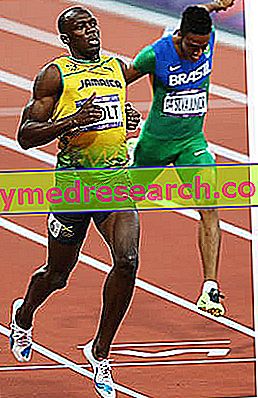The realization of the training for athletics takes place on the basis of 3 fundamental lines:
- Programming
- execution
- Control (test)

Periodization of athletics training
Periodization of training is an essential element in achieving the LENDING goal; it is clear, the decisions taken during the initial planning are absolutely indicative, since they represent a simple "trace" of the desired path, and (when necessary) must be reformulated / corrected based on the needs of the moment or period; however, it is necessary that the coach preaches (as precisely as possible) the course of events, in order to manage in an exemplary manner both the alternation and the continuity of the VOLUME and INTENSITY of the training or TRAINING LOAD.
NB . See Matizev's periodization scheme.
Training "load" and training effect for athletics
The load is a parameter that indicates QUALITATIVELY and QUANTITATELY the training performed by the athlete; the load is of 3 types:
- External load: QUANTITY of work done
- Internal load: EFFECT of training on the athlete (improvement of conditional and coordinative skills)
- Psychological load: subjective PERCEPTION of the work done
The external workload can be modulated in the various training MICROCYCLES (6-8 days each) so as to guarantee a GRADUAL increase in the stimulus useful for PROGRESSIVELY improving the physiological adaptations (super-compensation - part of the internal load) without excessively stressing the 'athlete (psychological load tending to over-training). The types of load modulation within the microcycle are:
- Constantly increasing load (progression from 1 to 6/8 days)
- Alternating increasing load with stationary load (progression on odd days 1-3-5-7 and stationary on even days 2-4-6-8)
- HIGH and increasing load alternation with stationary load (as above, but consistently raises the load after periods of moderate or low load)
- Alternation of high load and low load (progression on odd days 1-3-5-7 and low on the same days 2-4-6-8).
As for the MESOCICLO (30 days - unit of measurement greater than the microcycle) of the training for athletics, the load can be modulated as follows:
- Gradual growth in small and constant steps (constant increase from 1 to 4 weeks)
- "Wave" growth (see Matveev method - increase from 1 to 2.5 weeks and corresponding decrease)
- Growth with "gradual interruptions" (greater exploitation of super-compensation)
- Growth with "decreasing external load and increasing internal load"; alternation of micro-cells of different size (eg, decreasing load or 1 to 4) with the first microcycle of loading of the following mesocycle ALWAYS MORE. In this way the super-compensation of the discharge microcycle of the previous mesocycle is exploited.
We have seen how the training of athletics requires a very rigorous method in establishing goals and means or tools already at the beginning of the competitive season; well, the same is true for the management of microcycles, mesocycles, MACROCYCLES (the latter last from 2 to 4 mesocycles). A further breakdown of the season can be carried out based on the PERIODS:
- Introductory period, in which the general efficiency is mainly cared for
- Fundamental period, in which the increase of the general and specific training volume is preferred
- Special period, in which the intensity in view of the competitive period is increased
- Competitive period, in which important competitions are placed and the aim is to achieve maximum and equally long-lasting maintenance of the physical form obtained
- Transition period, also called competitive calm; consists of physical and psychological recovery before the start of another training cycle or season.
This periodization allows you to participate in only one competitive period during the year; if the competitive periods are 2 or more (of which, however, only 1 principal), it is better to use double periodization or multiple periodization. For example, a double periodization model that includes the two competitive periods in winter and summer, places the introductory, fundamental and special part in the months from November to January followed by the 1st race period, at the end of which the cycle starts again (but WITHOUT the introductory period) which stops at the end of August. From September to October the only annual period of competitive or transitional calm develops. Ultimately, double periodization includes only one introductory period and only one transition period, respectively at the beginning and end of the season.
Training control for athletics
There are some guiding principles that facilitate the assessment of both training and the chances of achieving predetermined hunting goals; the coach must therefore: a) choose the most significant indices to estimate the increase in performance (eg, evaluation of the maximal force or of the anaerobic threshold), b) regularly observe the dynamics and evolution of the psychophysical condition of the athlete, c) compare it to the desired results from the beginning of programming, d) record the values surveyed, e) document the salient interventions and any changes to the initial program (through the annual cycle, the quantitative model of the construction system, the program of the great stages of preparation, the individual card of the athlete).
Test for athletics training
Athletic tests are essential for the control of conditional progress in individual subjects and in the group; they represent:
- The training control measure
- The measure of training intensity
- The extent of training recovery
The tests must be programmed and repeated at the end of each mesocycle or, eventually, at the end of the macrocycle.
NB . The tests ALWAYS adapt and respect the dynamics of the load in the cycle concerned, placing itself strictly in the week at low or moderate load.
Bibliography:
- The track and field coach's manual - Part one: general information, races and march - Studies and Research Center - pag. 7:19 ..



